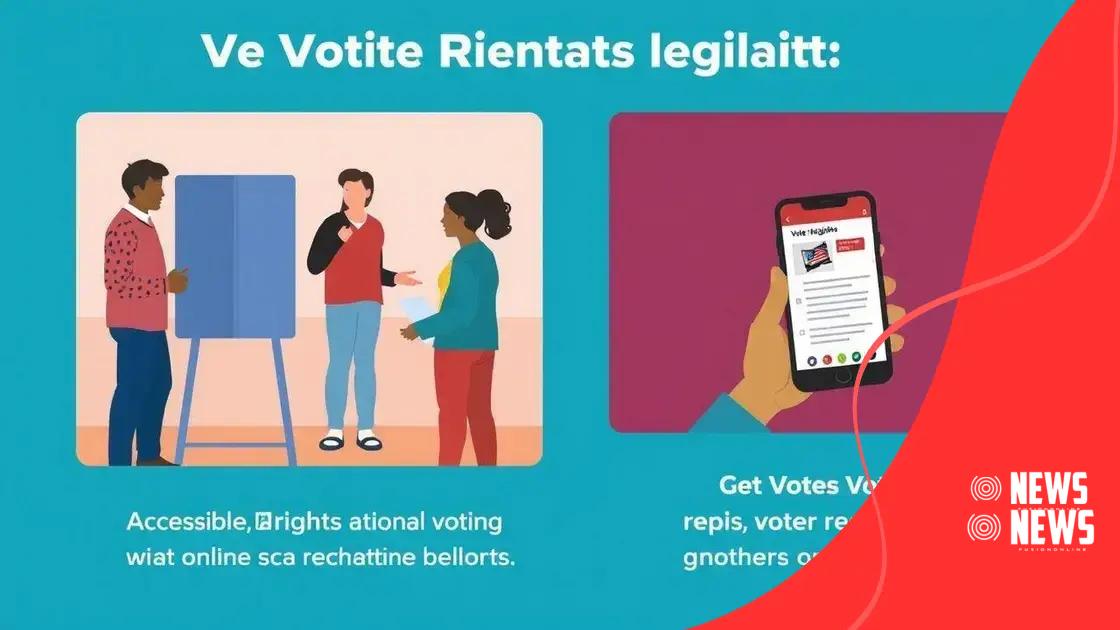Voting rights legislation: ensuring access for everyone
Voting rights legislation encompasses laws designed to protect and expand citizens’ access to the electoral process, addressing issues like voter discrimination, registration improvements, and barriers that hinder participation.
Voting rights legislation is a vital pillar of democracy, ensuring that every citizen has a voice in government. But have you ever wondered how these laws evolve and impact your ability to vote?
What is voting rights legislation?
Voting rights legislation refers to laws that protect and facilitate the right to vote for all citizens. These laws ensure that everyone has a fair opportunity to express their political views and participate in the democratic process. Understanding this legislation is essential to realizing how it impacts our society.
Key Aspects of Voting Rights Legislation
One major purpose of such legislation is to eliminate barriers that prevent individuals from voting. These barriers can include unfair identification requirements, limited access to polling places, or discriminatory practices.
Important Legislation in History
In the United States, key laws such as the Voting Rights Act of 1965 played significant roles in advancing voting rights. This landmark legislation aimed to eradicate racial discrimination in voting, paving the way for greater electoral participation.
- Expanded access for minority voters
- Provided federal oversight in elections
- Outlawed literacy tests and voter intimidation
Over the years, these measures have evolved to adapt to changing societal needs and challenges. For instance, recent discussions have focused on modernizing voting through technology, such as online voter registration.
Current Trends in Voting Rights
Today, voting rights legislation continues to face challenges. Many states propose laws that some critics argue could restrict access to voting. These contemporary discussions highlight the ongoing importance of voting rights legislation and the need for active engagement from the public.
In essence, understanding voting rights legislation helps us to appreciate the foundation of democracy and our role within it. Being informed allows citizens to advocate for fair practices and hold their leaders accountable.
Historical context of voting rights
The historical context of voting rights shows how the journey to secure the right to vote has evolved over time. From early struggles to modern advancements, understanding this history helps us appreciate the sacrifices made for the rights we enjoy today.
Early Voting Rights and Struggles
In the United States, voting was primarily restricted to property-owning white men during the early years of democracy. This meant that many people, including women and minorities, were denied their basic right to participate in elections.
The Fight for Women’s Suffrage
One of the most significant movements in the quest for voting rights was the fight for women’s suffrage. In the early 1900s, women organized protests and lobbying efforts, demanding the right to vote. Their hard work paid off when the 19th Amendment was ratified in 1920, granting women the right to vote.
- Women faced social and political barriers.
- Activists like Susan B. Anthony played key roles.
- Persistent efforts led to the eventual right to vote.
The struggle for voting rights did not stop there. After the Civil War, many African Americans gained the right to vote through the 15th Amendment. However, this was met with resistance, leading to the creation of laws and practices designed to suppress their votes.
The Civil Rights Movement
The Civil Rights Movement of the 1960s was pivotal in addressing these injustices. Activists fought against discrimination and for equal access to voting booths. Key moments, like the March on Selma, highlighted the urgent need for change.
As a result of their efforts, the Voting Rights Act of 1965 was enacted. This landmark law aimed to eliminate racial discrimination in voting, providing a significant step forward for equal rights.
Key components of current legislation

The key components of current voting rights legislation are designed to protect and expand access to the electoral process. Understanding these components helps us see how they ensure fair participation for all citizens.
Elimination of Discriminatory Practices
One critical aspect is the elimination of laws that discriminate against voters based on race, ethnicity, or other factors. This effort includes banning literacy tests and other barriers that historically suppressed minority voting.
Voter Registration Improvements
Another significant component is making the voter registration process easier and more accessible. Many laws now allow for same-day registration and online registration options. These changes encourage greater participation by simplifying the process.
- Automatic voter registration systems
- Online registration availability
- Extended deadlines for registration
Moreover, current legislation often focuses on enhancing the security and accuracy of voting devices. Ensuring that machines are reliable prevents fraud and boosts public confidence in the election process.
Protection Against Voter Suppression
Recent laws have also aimed to protect voters from suppression tactics, such as aggressive purging of voter rolls or limiting access to polling places. These measures ensure that every eligible voter can participate without undue obstacles.
This focus on accessibility and fairness is not just a matter of law but reflects a broader commitment to strengthening democracy. Promoting informed citizenship and encouraging participation are essential goals of today’s voting rights legislation.
Challenges to voting rights today
Challenges to voting rights today reflect ongoing struggles within the electoral process. Despite progress, various obstacles continue to emerge, threatening the accessibility and fairness of voting.
Voter ID Laws
One prominent challenge is the implementation of strict voter ID laws. Some states require voters to show a specific form of identification, which can disproportionately affect low-income individuals and minorities. These requirements create unnecessary barriers that hinder eligible voters from casting their ballots.
Voter Roll Purges
Additionally, aggressive voter roll purges have become a significant concern. States periodically remove names from voter lists to maintain accuracy. However, this can lead to eligible voters being erroneously eliminated from the rolls. Such actions often result in confusion on election day.
- Increased instances of voters being turned away
- Lack of clear communication about roll updates
- Disproportionate impact on minority communities
Furthermore, limited access to polling places poses a challenge as well. In many areas, especially urban centers, polling places are reduced or inaccessible, leading to long lines and frustration for voters trying to participate in elections.
Disinformation Campaigns
An emerging threat is the spread of disinformation regarding voting procedures and regulations. Misinformation can cause panic or confusion, discouraging individuals from voting altogether. This manipulation undermines public trust in the electoral process.
To combat these challenges, many organizations and activists are working to promote awareness and encourage civic engagement among communities. By highlighting these issues, they aim to protect and strengthen our democratic system, ensuring that everyone has a voice.
Future of voting rights legislation
The future of voting rights legislation is shaped by ongoing debates about democracy and equality. As society evolves, the laws governing voting must also adapt to meet the needs of all citizens.
Emerging Technologies
One significant trend is the incorporation of new technologies in the voting process. Innovations like online voting and blockchain can potentially streamline elections and increase accessibility. With these advancements, more people may find it easier to cast their votes.
Protecting Against Discrimination
Ongoing advocacy is essential to ensure that future legislation protects against discrimination. Activists are pushing for comprehensive reforms that address the needs of underrepresented communities. This includes enhancing protections against voter suppression tactics.
- Implementing automatic voter registration nationwide
- Creating stricter penalties for discriminatory practices
- Informing citizens about their voting rights
Moreover, as conversations around voting rights gain momentum, public awareness campaigns will play a crucial role. Educating voters about their rights and the legislative process can empower more individuals to participate actively in democracy. Grassroots movements will continue to rise, emphasizing the need for equitable access while challenging regressive measures.
Collaboration Between States
The future may also see increased collaboration between states to standardize voting practices. Having consistent rules can help eliminate confusion and ensure that every voter knows how to participate in elections effectively.
In summary, the landscape of voting rights legislation is evolving. As new threats and opportunities arise, maintaining a focus on inclusivity and fairness will be vital for securing the future of democratic participation.
FAQ – Voting Rights Legislation
What are the key components of current voting rights legislation?
Key components include eliminating discriminatory practices, improving voter registration, and ensuring access to polling places.
How do emerging technologies impact voting rights?
Emerging technologies like online voting can enhance accessibility and streamline the voting process for citizens.
What challenges do voters face today regarding their rights?
Voters face challenges such as strict voter ID laws, aggressive voter roll purges, and misinformation about voting procedures.
What is the significance of advocacy in voting rights?
Advocacy is crucial for protecting voting rights and raising awareness about issues that affect voter access and participation.





